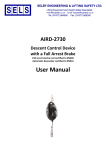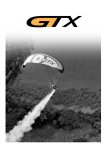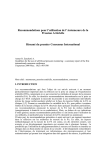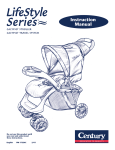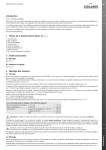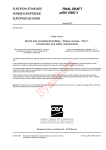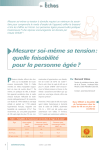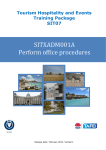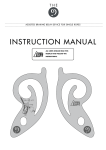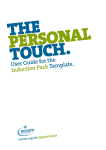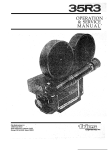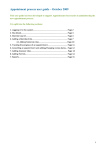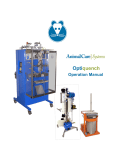Download Scout National Activity Centres Off Ground Manual
Transcript
Off Ground Training Syllabus – Trainer Manual. Version 3 – November 2011 (Skype Version) providing technical advice to Ropeworks Developments Ltd 7 Marine Road Colwyn Bay Conwy LL29 8PH [email protected] Scout Activity Centres The Scout Association Gilwell Park London, E4 7QW [email protected] 1 Scout Activity Centres – High Ropes Training Scheme •Formal theory training •Manual and log book provided •Practical training under supervision •Independent assessment and written test •Moderation - Audit 2 monthly (LI) •Restricted to work assisted with L2 staff •Independent Assessment and written test •Moderation - Audit 2 monthly (LI) •Proven Track record / CV •Site specific trained on systems •Annual audit by Trainer onsite. • Proven track record / CV • Attended Train the Trainer workshop • Attend training review meeting (at least bi-annual) • ERCA Trained to Access & Rescue •Oversee the scheme •Audit •Statistics •Liaison •Independent •Advise on new and best practice •Assessment of staff Trainee Instructor (Supervised and under instruction) Level 1. Instructor (Ground based. Competent. Current) Level 2. Instructor (Work at height with groups, rescue competent. Current) Senior Instructor (Manager of people / ropes facility) Trainer Inspector Training Coordinator Technical Advisor 2 Contents: Section 1. Personal Protective Equipment – safe use and correct fitting. 2. Identifying faulty or damaged equipment. 3. Knots . 4. Suitable methods of attachment to the rope. 5. Appropriate belay techniques. 6. Bottom rope setup. 7. Group Safety Briefing. 8. Safely operating a bottom belay. 9. Zip wire set-up and safe operation. 10. Fan Descender set-up and safe operation. 11. Abseil set-up and safe operation. 12. 3G Swing set-up and operation. 13. Aerial Trek set-up and operation. 14. Emergency Action plan. 15. Structure inspection and access. 16. Comfort Zones and Challenge by Choice. Page 4 9 11 15 16 18 20 22 24 27 29 31 36 39 41 44 NOTE: This information aims to be generic across all Scout Activity Centres but there will be situations where it is not the same as the site specific operating procedure. Under these circumstances the current operating procedure and risk assessments should be followed. Additional information can be found in the following documents: Site specific „Activity Procedures and Standard‟ and Risk Assessments. Adventure Activities Industry Advisory Committee (AAIAC): The UK Ropes Course Guide (Second Edition, Feb 2010) Health and Safety Executive: Work At Height Regulations 2005 (as amended). Scout Association Policy, Organisation & Rules (POR) Chapter 9 3 1. Personal Protective Equipment (PPE)– safe use and correct fitting When fitting PPE to participants, an instructor should talk them through the process and encourage them to do as much as possible themselves. By doing this it should mean the whole process takes less time if everyone does it together and groups will often do more than one roped activity meaning that they should be familiar with the process for any further sessions. Sit harness (Alpine type harnesses without auto-buckle system (ABS)): Point out the belay loop, buckles on the waist and legs straps. Hold the belay loop at the belly button, above hips. Wrap the waist loop around the waist without any twists. Pass through the buckle as specified in manufacturers guidelines and ensure when it is tight around the waist it is doubled back through the original hole in the buckle. Do the same with the two leg loops. Sit harness (Alpine-type with auto-buckle system): Ensure the harness is twist free and belay loop sits at the front of the body. Auto buckle system around the waist and legs should be appropriately adjusted so that its sits above the hips. A sit harness should not be so tight that it restricts movement but the participant should be able to fit their flat hand between the harness and their body. Alpine harness without auto-buckle system (ABS) Adjustable buckle Brenin Harness with auto-buckle system Belay loop Waist loop Gear loop Leg loop 4 Instructor Harness At all times instructors must use harnesses supplied by the centre. Some centres may provide specific harnesses to instructors where appropriate. Instructors should not use their personal harness because PPE safety checks do not record them. Chest Harness The use of these, when connected to a sit harness, prevents the possibility of a participant inverting whilst participating in a roped activity. They are also useful for people with small hips or large belly who may slip out of the sit harness. Two tie-in points (usually coloured) should be at the front of the chest. Gear loops under the arms. Auto-buckle system should be adjusted so that the harness is not loose and buckles should be on the chest or shoulders. Ensure there are no twists in the webbing – it should lie flat on the body. Example chest harness used on centre, others may differ: Adjustable buckle Tie in loops Helmet Placed on the top of the head, covering the forehead (when the wearer looks up they should see the colour of the helmet) Chin strap done up underneath the chin and adjusted so that it is tight enough to fit only two fingers between the strap and chin. Fit the cradle of the helmet by turning the dials/ adjusting the strap so that it sits comfortably tight on the head. The Camp Rockstar and similar pattern helmets can be fitted by adjusting the headband by sliding in or out. Shell Chin strap and buckle Cradle adjustment 5 Combi Sling One strap goes through each of the two „tie-in‟ loops of the chest harness. Attach the two straps together with the elastic loop. Karabiner goes through the loops at the base of the sling and attaches gravity loaded to the sit harness belay loop and is then screwed up. Slings Slings come in a variety of lengths, widths and colours and are the ideal alternative to an ill fitting combi sling. Thread through the „tie-in‟ loops of the chest harness and attach a karabiner through the two ends. Attach the karabiner (gravity loaded and with the gate facing out) to the belay loop as well and screw up. Some examples of slings: Sling strength in kN Rope Rope is made up of 2 main layers: Sheath (outer layer) which protects and holds the core together. The sheath is coloured and often indicative of the type of rope. Core (internal layer) is a series of strands which form most of the strength in a rope. Core Sheath 6 There are two main types of rope that will be used on the Activity Centres. These are also known as kernmantle rope because of their construction: Dynamic ropes will stretch when they are under a load, meaning that they are capable of absorbing some of the shock from a fall from height. This means that there is less pressure put onto the climber and their equipment. Static rope is generally used for abseiling and does not stretch as much as a dynamic rope. It is not suitable for use when there is a risk of the rope being exposed to a large impact, such as a fall. This kind of impact will place a large shock load on the climber and the equipment, so their use is avoided in such situations. Fall Factors A fall factor expresses the proportional seriousness of a fall. It is the relationship between the length of the fall and the rope available to absorb the impact force of the fall. It is calculated using the following equation: Fall Factor = Length of fall Length of rope used in the system The maximum fall factor which can occur is a fall factor of 2. This is very unlikely within the scope of what we operate at Scout Activity centres and is only possible when lead climbing. Fall factors will only occur on our centres if too much slack is left in the system by the belayer. Karabiners Karabiners are a universal means for attaching pieces of equipment together and appear in a number of different forms. Karabiners are strongest along their major axis, and because of this, the loads should always be kept as close to this as possible. HMS screw gate karabiner 7 A karabiner should be loaded with the weight pulling along the major axis. If the pull is in any other direction, the strength of the karabiner is less. Gravity loading a karabiner: It is best practice to gravity load a karabiner. This means that when a gate is closed it screws or twists down, with gravity. This should prevent it becoming undone when the karabiner is exposed to vibrations or contact with another object. Screw gate karabiners: These are 2 examples of locking karabiners. Each end is a similar size unlike the HMS. The difference between the two is the metal they are made with (Left = aluminium, Right = steel). HMS Karabiner with an auto-locking gate (tri-action): An HMS karabiner is characterised by one end being significantly wider than the other which is especially important when using an Italian hitch or clove hitch. The three pictures above are examples of karabiners used on centre. Others that may be encountered include (but are not restricted to) the following: Captive bar Karabiner. These will snap closed when released. Belay master. The black case goes over the screw gate. 8 2. Identifying faulty or damaged equipment PPE should be checked before each use which is the responsibility of the instructor on the session. More formal and detailed monthly checks will be undertaken by the appropriately trained person on-site. Faults Harnesses and slings: Rips, tears, cuts and fraying. Loose, broken or missing stitching. Burning. Spillages (e.g. chemicals or other liquids). Buckles should not be bent, distorted, loose, have sharp edges or appear to be wearing away the fabric at the attachment point. Functional check (if appropriate) e.g. on auto-buckle systems. Helmets: Straps have no visible wear or damage. Cradle has no visible damage (cracks, stress marks or large chips) and attached to the shell correctly. Functional check on chin buckle and cradle adjustment. Discolouration. Rope: To check the rope, feed it through your hands from one end to the other. This should be done when uncoiling the rope, prior to use, as well as when recoiling after use. Bulges and flat spots will suggest damage to the core. Flexibility: age will often make a rope stiffer. Fluffiness in the sheath. Sheath fibres pulled or broken. Burns (darkened, shiny or silvering areas where rope may have melted due to excessive heat when passing through a belay device). „bulging‟ in the rope. Damaged sheath, exposed core. Metal Components As a rule, metal components are not affected by UV radiation and therefore can be used indefinitely, as a user you are to confirm the item is working correctly and there is not an excessive amount of wear, this is deemed not excessive if less than 10% of the total material. Karabiners: No visible damage including bends, breaks or large chips. Functional check that the gate will snap shut when released and locks, if applicable. 9 No sharp edges or excessive wear. Belay devices (Figure of 8, Gri-gri etc): Excessive wear (especially at attachment points and where rope has contact with the belay device). No sharp edges. Functional check to ensure locking device pinches the rope, where applicable. No damage to the handle or lever. Lowering lever Karabiner attachment point. Procedure for logging a piece of faulty equipment If an instructor believes that a piece of equipment should not be used, they should take it out of use and label it with the suspected fault (See SOP). This can then be checked by the person in charge of monthly checks who will either reinstate it into use, or remove completely. These faults should be logged in the monthly check sheets as being „monitored‟ and this will ensure that if the issue gets worse it is taken completely out of use. Process: Tag or mark item in a way that others are aware it has been taken out of use and the reason for doing so. Place into the allocated quarantine box, or similar. Make the relevant member of staff aware of the issue (usually the person in charge of conducting monthly checks) During monthly checks, this item will get a thorough inspection and reinstated, if appropriate. Policy for renewal/ replacement of equipment In line with manufacturing guidleines, the retirement policy is 5 years for „soft‟ equipment (i.e. harnesses, ropes and slings) and a 5 years pre-user life (or shelf life). Helmets have a 10 year user life or shorter due to wear and tear or damage. Note: User life starts when the item is removed from its wrapper. For metalwork (karabiners, mallions, SRB etc) the user life is indefinite or when required due to wear and tear/ damage. 10 3. Knots Overhand knot on a bight This will mostly be used in the dead end of the rope after it has been pulled through the belay device. The use of the knot will ensure that no rope will slip through the auto-locking gri-gri even if the locking device fails, the knot will block any movement of rope. To tie: 1. Make a loop. 2. Pull through the working end. Stopper Knot Generally used to finish off a rethreaded figure of eight knot to tidy up the loose end of rope and reduce slipping through the knot. To tie: 1. Wrap the working end of the rope around itself for at least two full turns 2. Pull the working end back through these turns and pull it tight. Rethreaded figure of Eight This is the chosen knot for most climbers. The knot is tied directly into the belay loop of the harness, keeping the number of pieces of equipment required to a minimum. This knot is what all harness manufacturers will recommend to use for climbing in their harnesses. To tie: 1. First, tie a single figure of eight a suitable distance from one end of the rope (Distance can be roughly measured as the distance from the ground to the attachment point on the participant). 11 2. Thread the rope through the attachment point (either belay loop or belay loop and chest harness tie in points). 3. Rethread the figure of 8 following the route of the single figure of 8 and finish off with a stopper knot. Figure of Eight on a bight / Double figure of eight This knot will be used in a situation where a karabiner will be used to attach a participant or a piece of equipment to the rope. To tie: 1. Use the bight as the working end of the rope. 2. Create a loop and pass the bight all the way around the dead end of the rope. 3. Push the bight though the original loop, checking the „8‟ is visible. 4. Ensure there is no crossing over and the knot is neat then tie a stopper knot. Clove Hitch The clove hitch acts as a self-tightening knot often used in situations where the length of a running end will need to be adjusted, for example in a ground anchor set-up where the height of the belayer will change. To tie: 1. Form two back-to-back overhand loops in a rope, and then put the top loop underneath the bottom one. 2. Drop both loops into the karabiner and tighten. 12 To test: Pull on one of the loose ends of the knot, and where no slack is allowed through, then the knot is tied correctly. Slippery Hitch This knot is used to safeguard a belay device (e.g. Gri-gri on zip-wire). The use of the knot will ensure that no rope will slip through the autolocking gri-gri even if the locking device fails, the knot will block any movement of rope. To tie: 1. Create a loop with the working end of the rope coming over the top. 2. Working end should then be brought behind the loop and pulled through the back of the original loop. Slippery hitch tied on a gri-gri. 13 Italian Hitch This knot is commonly used for belaying, mainly in a top rope situation or where other devices (gri-gri, belay plate) are unavailable, or unsuitable. It creates friction similar to a belay device, meaning that is simple to hold a large weight and lower it to the ground. The knot is controlled from the front and is „locked off‟ when the dead and live ends are parallel to one another. To tie: Similar to the start of a clove hitch 1. Form two back to back loops. 2. Fold the two towards one another, like closing a book. 3. Put the loops through the karabiner and test by ensuring the knot will allow free movement of the rope when pulled on either end. Tying off an Italian Hitch This knot is often used in an abseiling situation as it can be tied and released with weight on the rope. It forms the base of a releasable abseil setup. To tie: 1. Tie an Italian hitch as above. 2. Take a bight of the dead rope and tie a slippery hitch then pull enough rope through to create a metre long loop. 3. Tie 2 half hitches around both the dead and the live rope. 4. This should leave an adequate tail of 150mm which may be clipped back. 14 4. Suitable methods of attachment to the rope In all bottom rope belay situations, a double rethreaded figure of 8 and stopper knot should be used. This will either be attached to the belay loop of the sit harness or through both „tie-in‟ loops of the chest harness as well as the sit harness. In a top rope situation (fan descender, zip wire), for ease of detachment from the rope, the participant should be clipped in with a double action locking karabiner on the bight of a double figure of 8 and stopper knot. This karabiner should be clipped to the belay loop, the top attachment point of the combi sling or between the two tie in loops of the chest harness on the sling. 5. Appropriate belay techniques 15 There are 2 techniques which are suitable to use with novice and guestto-guest belayers. The instructor will be responsible for deciding on the most appropriate technique for the group and then coaching and monitoring the group as it is used. Typically the five point belay method would be used with older and more experienced groups, whereas, the bell-ringing technique is more suited for including as many of the group as possible and also being simpler and quicker to teach especially for younger groups and those with less time to learn the skills required for five point belay. The five point belay technique is best practise and should always be used when staff belay. Five-point belaying (V, knee, 1, 2, 3) Start position - One hand (known as the guide hand) is placed on the live rope at shoulder height. The other hand (known as the brake hand) is placed on the „dead‟ rope next to the belay device. 1. Guide hand pulls down on the live rope, removing any slack, towards the belay device. Brake hand pulls the rope up and through the belay device, creating a ‘V’ shape with the rope. 2. Once the guide hand reaches the belay device, the dead rope should be held tight by the brake hand down at the knee. This is the locked off position. 3. Guide hand is then moved down onto the dead rope, above the brake hand.(Position 1) 4. Brake hand is moved up the dead rope, above the guide hand and close to the belay device an in the start position – both hands should still remain on the dead rope. (Position 2) 5. The guide hand is then returned to the live rope start position, ready to pull in the rope again and repeat the process.(Position 3) Bell-ringing One participant (Belayer 1) is clipped into the anchor and will be responsible for the live rope. Another participant (belayer 2) is positioned facing belayer 1, ideally with his back to the climber. This person becomes responsible for the dead rope which they must not let go of. (Additional belayers can be involved in holding the dead end). As the climber moves up the wall the slack will be taken in by pulling down on the live rope and then the other belayers pull the rope though the belay device into the locked off position. Those controlling the dead rope must be reminded to keep the rope locked off as much as possible. Lowering-off procedure Instructor should take full control of the rope for this process regardless of an individuals or group experience. The instructor should aim to take control before the climber has committed or fallen on the rope. This is not always achievable but desirable. 16 Participants to remove their hands from the rope to prevent rope burn. The instructor takes in all slack rope in the system and holds the dead rope tightly with both hands, with the rope @ 180% through the belay device, this is called a „Take position‟. The instructor asks the climber to lean back and hold the knot in front of them. Untie the slippery hitch (if appropriate). Ask one of the participants to untie any other knots further down the dead rope. Start with the guide hand low on the dead rope and brake hand on the black lever of the gri-gri. Open the gri-gri so that the rope can move slowly through the system, maintaining control with the guide hand static on the rope. Lock off the gri-gri using the black lever once the guide hand reaches the gri-gri. Move the brake hand back down the dead rope. Repeat the procedure until the participant is safely on the ground. Belaying on a top rope Similar to a bottom rope belay only using an Italian hitch in place of the belay device. The Italian hitch should be placed so downward pressure can be exerted as a breaking action, ideally with the knot at head height; any lower and the ropes become more difficult to control. Pull up the „live‟ end, attached to the belayer, towards the Italian hitch. Pull down the „dead‟ end so the rope moves through the Italian hitch to tighten the „live‟ rope. For the „locked off‟ position, both ropes should be parallel to one another. Should a participant need lowering back down, this is as simple as allowing the rope to slide through the Italian hitch whilst ensuring the dead end of rope is under control and prepared in case of the participant falling if down climbing. Tying off a top rope This should may not be required but may be useful when a participant wishes or needs to descend the pole in the same way they came up. This will probably only happen if they decide not to continue to participate and wish to return to the ground. Useful if your participant is stationary and you need to free up your hands whilst ensuring their safety. Use a slippery hitch and two half hitches to tie off their safety rope. See „Typing off and Italian Hitch‟ in section 3. 17 6. Bottom Rope Setup Equipment required 2 1 1 1 x x x x screw gate karabiners. Steel Tri action HMS karabiner. Gri-gri. Dynamic rope (or semi static rope for crate stack). Stages of setting up the bottom rope Uncoil the rope and perform a check for faults and damage. This is done by running the rope through your fingers checking for any lumps bumps or flat spots Attach the tracer cord (if present) to one end of the rope using a clove hitch and pull through the SRB or karabiners. Ensure the smooth running of the rope through the SRB or karabiners. Ground anchor set up Attach a Steel HMS tri action karabiner to the ground anchor. This can be either a bag, tyre, sling, eye bolts, wires, bar, fixed point or chain. Tie a figure of 8 loop on the bight with a stopper knot on to the belay end of the rope Attach the rope to the steel HMS Karabiner that is attached to the ground anchor using a clove hitch. This is used so it can easy adjust to fit any participant. If using a screw gate karabiner this need to be gravity loaded Attach the two screw gate karabiners to the bite of the figure of eight one of them is for the belayer and the other is for the Gri gri Set up the gri gri following the manufactures guidelines and the diagram on the Gri Gri, attach this to one of the screw gate karabiners and insure that the karabiner is locked and gravity loaded In the other end of the rope tie a single figure of eight ready to be tied in to the climber 18 Gri Gri Locking belayer karabiner Figure of 8 on the bight with stopper Clove hitch Ground anchor Boa karabiner with auto lock gate Take Down Untie the clove hitch from the karabiner that‟s attached to the ground anchor and remove all metalwork and knots from the rope. Replace the tracer cord and remove the rope as follows: o Tie both ends of the rope together, pulling the knot to the top of the structure, next to the SRB or karabiner. o Attach the tracer to the rope using a clove hitch. o Pull the rope until the tracer has passed through the SRB and returned to the ground. o Rope can now be removed make sure there is no one below the SRB or in the imitate are when this is done, also shout “below!” before the rope is falls to warn people Tracers should be tied to the structure out of reach of unsupervised guests. 19 7. Safety Brief The safety briefing should be delivered thoroughly, with minimum amount of deviation as possible. The contents of the safety briefing will vary by task and activity. Safety briefs should include: 01 02 Topic Introductions Fitting of PPE 03 Define boundaries and no-go areas 04 Ethos and Behaviour 05 Clothing and Equipment 06 Eating and Drinking 07 08 Medical Instructions 09 Site specific safety issues Remarks Role and responsibility You need to explain and demonstrate how to fit personal protective equipment (Helmet and harness) correctly and tell them that all equipment should be checked by an instructor before they leave the ground. You must show them where the safety areas are ,explain why they are there and explain that helmets must be worn by all participants (including the instructor) and Spectators, when they are in the area Tell them that they must behave in and appropriate way, only use encouraging language with other group members and keep quiet if the instructor is talking. Do not harass someone that does not want to take part in the activity. Challenge by Choice Actions on needing a toilet. Clothing requirements, no loose clothing or jewellery. Pockets should be emptied. Shoes should cover the whole of the foot and be tied tightly. Scarf and neckerchiefs need to be removed and glove cannot be warn when belaying. No Eating within the ropescourse area No Smoking No drinking Identify any medical issues Advise all participants to react to directions from the Instructor Element specific as specified in the SOP / APS. Once you have covered all the points above you then cover the activity specific requirements, below are a list of some of the different risks for each activity the full content can be found in the APS for each activity Climbing outdoors Participants are not allowed to climb onto the flat part at the top of the wall Participants should not use the metal leading clips that are on the wall as hand or foot holds They must not pull on their rope to help them 20 Jacobs Ladder out/indoors Participants are not allowed to use the metal wires that are on either side of the ladder. If participant want to pull each other up this must be done using the back of the harness. When they are climbing they need to stay on one side of their side of the Jacobs ladder so that they do not cross and tangle there ropes. Participants can stand on each other knees to boost someone up. Leap of faith Participant must not jump for the trapeze until the instructor has given them the count down. Participant must not go upside down when they are being lowered off. If they are jumping with someone else they must stay on their side of the platform to make sure the ropes do not become tangled up. All aboard Participants must climb one at a time. When they reach their platform they must move to the correct. corner and stay there during the activity so they do not cross ropes with someone else participant must not push each other off of the platform. High See Saw When climbing up they must watch their hands on the hinge of the see saw so they do not trap their fingers. When waiting on the see saw they must stand still and not rock the see saw. The must not pull on their rope or other peoples ropes. They must move to the same side of the see saw that there rope is on, so they do not cross the ropes. Crate Stacking Show and explain how the crates lock together. Tell the People that are passing the crates up that they cannot stand on any crates. Tell the group where they must move to if the crate tower falls down. Tell the group that they cannot throw the crates up to the people on the tower. Tell the participants to make sure their ropes do not tangled. If they are they must untangle themselves before being lowered to the ground. Tell the group to be aware of falling crates. Climbing indoors Participant must not put their hand in the metal rings on the top of the wall. They must not pull on their rope to help them. 21 When being lowered they must walk down the wall no jumping/ bouncing is allowed. Ladder climb They must stay on the same side of the ladder that the ropes in on. When they are being lowered down they must keep their feet away from the ladder so they do not become tangled up in it. Gauntlet Participants are not allowed to use the metal wires on the side of the activity. When climbing on the net participant must take care not to become tangled. Wobble Pole When participants are climbing they must watch their hand on the metal work holding the pole together. If more than one person is climbing they need to make sure they are staying on their side of the pole. When you are delivering your safety briefing make sure that you speak clearly and loudly so that everyone can understand you and hear you. When you are standing make sure everyone in the group is able to see you and that you can see all of them, make sure that the group have their back to the sun as this will be one less dictation make sure that the group know if they misbehave or do not listen during the safety briefing that they will be unable to take part in the activity. 8. Operating a Bottom Rope Belay Ground belay Attach the belayer into the ground anchor using the appropriate screw gate karabiner into the belay loop. Ensure the length of rope between the ground and belayer is adjusted so that it is fairly tight. This is to ensure that the ground will take the weight of the climber, not the belayer who only acts as a secondary back-up for the system. This is done using the clove hitch. Depending on the age and experience of the group demonstrate and explain the most appropriate belay method (see section 5.) Check the belayer‟s understanding of their role by asking them to demonstrate several times how they will take in the slack rope and „lock off‟. Have a practice run by getting the climber to walk from behind them towards the wall. Ensure there is (at least) one person backing up the dead end of the rope. Explain to the belayers that when the climber wants to come down they must call an instructor. 22 Climber Brief Follow instructions from the ground. If the rope seems slack, stop and allow the belayer time to catch up. Tell them how they are going to come down and that they have to call you when they want to come down. Final Departure Checks Ensure the harness and helmets are put on correctly, according to the manufacturers guidelines. See section 1. Ensure that the harnesses fitted without ABS are correctly threaded back upon themselves, so that they are in a “C” shape opposed to the “O” shape. Tie the participant into the rope using a re-threaded figure of 8 knot through the belay loop (and chest harness if in use). See section 4. Ensure the ropes are not twisted and all karabiners are connected correctly, gravity loaded and screwed up. Operation As they begin climbing, monitor the belayer. Tie an overhand knot into the rope, close to the gri-gri once the climbers feet are about 2m from the ground. If more than one climber is being supervised ensure you do not send the second participant off the ground until the first security knot has been tied on the first climbers belay. Continue to tie overhand knots as the participant moves upwards, at least once when they reach half way up the element. If necessary, when the climber reaches the top, a slippery hitch should be tied on top of the gri gri. This needs to be done if the climber is not going to be lowered straight away usually in the event of there being more than one climber e.g. Jacobs Ladder, Crate Stacking etc Problem solving in a bottom rope situation A Level 1 instructor is only able to intervene verbally, and not physically, with a participant who has frozen or will not continue with the off ground activity. Intervening physically with a participant is often a last resort and will not often be required if the appropriate technique is used to talk them down off the element. With an appropriate introduction to the activity, most participants should feel safe and comfortable with the activity. As an instructor, you will develop an ability to understand which participants are likely to struggle more with the activity. The following is a general idea of the process which should be followed in such a situation: 23 1. Encourage a participant to continue, sometimes individuals just require some reassurance about their performance and will be happy to continue. Always use positive and appropriate language. 2. Ensure all the slack has been removed from the system and ask the participant to put all their weight onto the rope and move away from the wall/ specific element. They can then be lowered safely to the ground. This will give them reassurance that the rope will keep them safe and may make them want to try the activity again. 3. Climbing back down the element can often be more reassuring for some participants. Ensure you are always in good control of their rope incase they were to slip off. All of these techniques will need you, the instructor, to be patient and sympathetic towards a participant. It is important not to „push‟ them too far as this could result in the activity have negative effect upon them. If anything gets caught in the Grigri system then you need to get the pressure released from it as quickly as possible. This can be done by getting the client to stand on something, such as the climbing wall or a stack of crates. If it is hair the easiest option is to cut it off. You need to be very careful if someone does get a finger caught in the system as it can damage their skin, so avoid all fingers and objects going in it in the first place. In cases of entrapment, contact a senior member of staff to assist you and then to assess the level of risk. 9. Zip Wire Setup and Operation Equipment required (per wire) 1 x trolley 3 x steel tri-action HMS karabiner 1 x safety rope (dynamic ) 1 x descent rope (static ) 1 x Platform Safety (dynamic ) 1x trolley safety rope (dynamic) 1 x Belay Rope (dynamic) 1 x gri-gri 4 x locking karabiners (preferably double action) Setting up the equipment Zip trolley setup Attach a Steel HMS tri Action Karabiner to the trolley gravity loaded. The Static descent rope and the dynamic Trolley safety rope need double figure of 8s with stopper knot tied into one end then clip them on to the trolley karabiner. 24 In the other end of the trolley safety rope tie a rethreaded figure of 8 to a locking double action karabiner. Thread the gri-gri as directed in the user manual on the static rope. Attach a locking karabiner to the gri-gri. Trolley Setup Double action karabiner tied on with a rethreaded figure of 8 and stopper knot to the short safety rope. Gravity loaded boa karabiner attached to trolley. Gri Gri threaded with the descent rope. Double figure of 8s for the descent and safety rope clipped in to the boa karabiner. Belay master attaches the gri gri to the participant. Platform The Platform safety is made up of two figure of 8s one of them has a Steel HMS tri action karabiner clipped on to it the other has a double action locking karabiner attached to it. Platform Safety Rope Longer of the two safety ropes for platform safety. Double action karabiner attached to rethreaded figure of 8 with a stopper. Boa karabiner attached to double figure of 8 with stopper. 25 Set up the belay rope for the participant if using a platform on a pole or exposed tower, using an Italian hitch in a Steel HMS Tri action karabiner through an eye bolt. The end which will be attached to the participant should have a double figure of 8 and stopper knot tied into it with a locking karabiner on the end. Belay ropes Italian hitch through boa karabiner Belay masters Double figure of 8 and stopper knots. Accessing the wire Instructor should access the wire using a lad-saf and/or cows tails and secure themselves to 2 primary attachment points whilst „working‟ (see Section 13 – Safe access …) The instructor should then place the trolley onto the wire. Sending a participant down the zip wire The participant should ascend to the platform in a safe manner, as directed in the operating procedure. Attach the participant to the safety rope on the platform or lock off the Italian hitch (see SOP)whilst zip wire equipment is prepared. Attach the trolley safety rope to the participants chest harness and the belay master and gri-gri to the sit harness. Tighten the static rope through the gri-gri so there is no slack between the participant and the trolley (except for slack given by the wire itself). The safety rope should be loose compared to the static rope so that the participant can easily remove the rope from their chest harness before they are lowered. Tie a slippery hitch in the static rope on top of the gri-gri. Coil the static rope up loosely and place over the arm of the participant, or in their hand. 26 10. Setting up the Fan Descender Equipment required 1 x Dynamic belay rope 5 x Steel HMS Tri Action karabiners 1 x shock absorber 1 x fan descender bar 1 x bar safety rope ( Dynamic) 1 x platform safety rope (Dynamic ) 3 x locking karabiners Setting up the activity equipment On the ground set up the descender equipment. A Steel Tri Action HMS karabiner should be attached to the main decender wire, followed by the shock absorber. Two Steel Tri Action HMS karabiners are attached into the other end of the shock absorber, one is attached to the bar and the other will hold the safety rope. In one end of the safety rope, tie a double figure of 8 with stopper and attach a locking karabiner. This rope should then be attached to the spare Steel Tri action HMS karabiner on the shock absorber using a clove hitch. This allows the rope length to be easily adjusted depending on the height of the participant. The rest of this rope needs to be tied with an overhand knot and clipped out of the way so it will not hit the participant in the face Set up the belay rope using an Italian hitch in a Steel HMS Tri action karabiner through an eye bolt. The end which will be attached to the participant should have a double figure of 8 and stopper knot tied into it with a locking karabiner on the end. Set up the Platform safety rope by tying a double figure of eight and a stopped know in to both ends of the rope in one end Clip a Steel HMS tri Action karabiner, this is then attached in to an eye bolt, in the other end attach and locking karabiner ( preferably and snap lock karabiner) 27 Fan Descender Setup Top boa karabiner connected to the wire. Both karabiners connected to the shock absorber must have opposing gates. One of which attaches to the bar. Clove hitch ties on one of the boa karabiners and spare rope is tied with an overhand knot and clipped out of the way. Double figure of 8 with a belay master karabiner. Sending the participant off the platform The instructor at the bottom should attach the participant to the belay rope by the combi sling on the chest harness. Belay the participant up the pole and once they reach the platform, attach them to the safety rope, using the snap lock karabiner. This should be attached to the belay loop on their harness. Only once this is done, remove the belay rope. Attach the bar to the participant and adjust the rope so that their arms can stretch to full length but there is not too much slack in the system. 28 Check all karabiners are locked and that the instructor on the ground is prepared. Brief the participant to keep their arms straight and to bend their knees as they land. Detach the platform safety rope and direct the participant off the platform. Ensure that as the participant steps off, they need to take one large step to insure that they clear the platform. ( the instructor may need to be prepared to push them forward if they are not going to clear the platform Instructor on the ground should aid the participant in landing on their feet. Bar should be detached from the participant and released to return to the instructor on the platform. 11. Abseil set-up and safe operation Equipment required (not including access to tower) 4 x Slings 2 x HMS screw gate karabiners 1 x additional karabiner 1 x Figure of 8 device 2 x screw gate karabiners 1 x static abseil rope 1 x dynamic safety rope Setting up the activity equipment Slings should be attached around designated attachment points. Join two slings together with a HMS screw gate karabiner. Static rope should be attached to one of these top HMS screw gate using an Italian hitch which will be tied off (see diagram). Ensure the rope reaches the bottom of the tower (rope will stretch a little when weight is put onto it). Figure of 8 device should be threaded onto the static rope, along with a screw gate karabiner attached. This may be used in conjunction with a short sling to prevent twisting. Dynamic (safety) rope has double figure of 8 on a bight and stopper knot in both ends. Then attached to the other top HMS with an Italian hitch. Dead end of the dynamic rope will be loosely coiled to one side allowing it to easily unravel as the abseil participant travels down the tower. To tie a rope off, see section 3, „Tying off an Italian Hitch‟. Site Specific There are different platform access methods, safety attachment points and anchor setup for various centres: Platform access – top belay on an Italian hitch, fall arrest block, stair, bottom belay for initial instructor access or some may use a shunt. 29 Safety attachment points – using a locked off belay rope, sling attached to an anchor point or none used due to safety railings in place. Anchor setup – wrapped or clove hitched slings on single or double scaffold bars. Example Abseil setup Central Tube on Tower Top = Screw Gate Karabiner Slings clove hitched to Tube Figure 8 Knots Figure 8 Knots Abseil Rope attached to karabiner with locked off Italian Hitch Safety Rope – belay using Italian Hitch Tower safety: Karabiner attached to belay loop on belayer‟s harness Lowering a participant Participant is attached to safety and abseil rope – safety rope should be at the top. Participants are directed to control the abseil rope, keeping their fingers and hair away from the figure of 8.The faster the rope moves through the figure of 8 device, the quicker they will move down the tower. Legs should be kept shoulder width apart with their feet flat against the tower. Instructor to pay close attention to participant as they move down the tower. The safety rope should not be held so tightly that the instructor is in complete control of the speed of descent but should be prepared to take complete control in the event of the participant letting go of their rope or similar. 30 Rescue procedure Where a participant becomes unconscious the method required to bring them safely to the ground is simply to lower them to the ground using the safety rope. This is achieved by doing the following: Tie off the participant‟s safety rope. Untie the two half hitches and then the slippery hitch in the static rope. Unclip the Italian hitch from the karabiner and throw the static line to the ground being careful not to hit any participants on the ground. Untie the two half hitches and slippery hitch in the safety rope, (ensure the dead end of the rope is kept under control) and take full control to lower the unconscious participant to the ground. There may be situations where the participant may become entangled in the abseil device e.g. their hair, fingers. In order to release them from this situation the static rope should be released or slackened using the following process: Tie off the participant‟s safety. Untie the two half hitches and slippery hitch tied in the static rope and pull the required amount of slack through to release whatever is entangled Retie the knots in the static rope. Untie the knots in the safety rope (ensure the dead end of the rope is kept under control) and lower the participant until they can regain control on the static rope. Continue the abseil as normal. Site Specific There are many differences between centres regarding setup, access and operation of an abseil session. The details can be found in the SOP. Examples: Youlbury- Access via stairs Hawkhirst- tracer through SRB then the instructor can be bottom belayed up the ladder where they then change the system to top belaying. Ferny Crofts- On main tower the set of stairs is climbed first. Then the abseil safety line is attached using an auto-locking karabiner and the instructor belays them up. On the smaller tower the shunt is used to climb the ladder. 12. 3G Swing Set-up and operation Equipment required 2 x swing seats 4 x triangular maillon rapides 4 x short slings 1 x length of safety rope 6 x screw gate karabiners 2 x captive bar karabiners 31 1 x length of static rope 1 x pro-traxion and karabiner 1x length of drain pipe to protect pro-traxion 2 x trio pulley 1 x three-ring circus 2 x large screw gate karabiners (or delta maillon) 1 x pull cord 1 x static rope with pipe protection Rescue equipment 1 x gri gri 1 x locking karabiner Site Specific: 1x long sling - GP Pulley set-up Tie a double figure of 8 and attach the bight of this with a karabiner to the bottom gold loop at the base of one of the pulleys using a gravity loaded steel screwgate karabiner Thread the rope through the lower of the two blocks on the second pulley, and then back to the first. Thread the rope a second time through both pulleys, leaving the end of the static rope loose and coming out of the back of the top pulley nearest where the pole will be and on the same side as the protraxion will be. Close the two pulleys and attach a large screw gate karabiner (or delta maillon) through each one. Check the smooth running of the rope through the pulleys. There should be no knots or twists. Starting point 4:1 pulley system setup Double pulley Double figure of 8 and stopper 32 Ascend the pole (as per operating procedure) and secure the pulley with the loose end of rope to the eye bolt at the top using the large screw gate karabiner or maillon (see SOP). Ensure the loose end comes out the back of the pulley nearest the pole and on the same side as the protraxion. Eyebolt Maillon Pulley extension rope From the pole, slowly release the rope holding the metal bar up. On the ground, attach the pro-traxion to the bottom eye bolt and thread the static rope through according to manufacturer instructions. Check that it locks on the rope correctly. Ensure that there is a pipe around the rope on top of the protraxion to avoid fingers getting caught during pulling. Set up the rescue equipment ensuring it‟s ready to use. Plastic tubing Teeth Threading the protraxion using diagrams on the metalwork. Cam Swivel Seat set up Attach a steel screw gate karabiner to each of the 6 eye bolts on the main bar. Attach a short sling to the 4 outer karabiners for the seats. Attach the triangular maillons to the seats and to the ends of the slings and secure all karabiners. 33 Thread the safety rope through the two central karabiners. Tie clove hitches to the unused karabiners on the main bar. Each end of the safety rope should reach to each of the seats, with double figure of 8 on a bight tied. The pull cord should be attached to one of the seats and threaded through one of the karabiners on the bar to keep it out of the way. Attach the bights of the figure of 8‟s on the end of the static line (with pipe protection) into the triangular maillons – one on each end and one through both central maillons. Clove hitches Triangular Maillons Black rope attached to 3 ring circus Quick release set-up Attach the 3 ring circus to the pulley system up to the main pole using the overlapping rings. Captive bar gate karabiner Thread the cable tie through the pull cord on the 3 ring circus to with a figure of 8 and stopper secure Slingsit in place. 3 Ring Circus Overlapping rings Trigger string Safely sending the participants off-ground Check correct application of PPE. Participants sit in the swing seats. Shoulder and leg straps done up and adjusted to fit comfortably. Safety rope is to be attached to the belay loop of the sit harness and the clove hitch above adjusted so that there is no slack in the rope. 34 Directions are given to the participants as to how and when to release the system when they have been hoisted to their desired height. The instructor should check the quick release set-up, and ensure the protraxion cam is flicked on by pulling up on the hauling rope and finding there is no rope coming back through. The instructor should explain to the rest of the group that the hauling rope is to be pulled by grabbing the rope by the instructor who is standing in front of the protraxion and walking towards the tree or bucket pulling the rope with both hands. Once the participant gets to the tree or bucket they are to let go of the rope and walk back to the front to grab the rope by the instructor and begin again. All the while the instructor checks and encourages the swing participants. The instructor checks the area for safety and then instructs the participants in the swing to pull the quick release cord. Move the rope bucket back up to the protraction so that the rope is not running along the ground before it goes up to the pullies. As the swing is slowing down, release the protraxion and lower the pulley; hauling the pull down rope to one side so that the swing does not hit it. When the swing has stopped the guests can be assisted out of the seats. The quick release set is re connected and the pro-traxion cam set on. The next pair of participants is called forward and the activity continues until the whole group has had a go. Pulley connection Top wire connection ‘D’ Ring Connection Point Down haul rope 3 Ring circus connection Yoke Rescue This process will only be required when the quick release may not work correctly, or the participants cannot be persuaded to pull the cord. Thread the gri-gri with the static rope coming from the pro-traxion. This should be done at the location specified in the operating procedure. 35 13. Take in all the slack on the rope through the gri-gri and tie a slippery hitch with two lock off hitches to ensure there is no movement of rope through the gri-gri. The gripping „teeth‟ of the pro traxion can now be released by getting the group to haul the rope one step towards the tree / bucket and then one step back until the weight is now on the gri gri. The slippery hitch can now be removed and the gri-gri is used to lower the seated participants back down. The technique used for lowering should be the same as in a bottom rope belay situation, ensuring the dead end of the rope is controlled at all times. Aerial Trek set-up and safe operation The following details are relevant to those courses using the „klippa‟ system, rather than a continuous course Equipment required per element wire 1x petzl trolley 1x delta mallion rapide 1x length of dynamic rope 1x metal triangle for kilppa 1x auto-locking karabiner Below is a labelled picture of the klipa: Second point of insertion for metal triangle Blue point of insertion for metal triangle Toggle used for locking metal triangle into place Karabiner for attachment to harness Activity Set up Instructor should access the activity area following guidelines later in this document. 36 The Petzl trolley should be placed onto the activity wire, and secured in place with the delta mallion rapide. The metal triangle and auto-locking karabiners should be attached to each end of the rope using a triple fishermans (stopper) knot. A double figure of 8 should be tied and the bight placed into the delta mallion. A clove hitch is now tied through the delta mallion as well using one of the lengths. Both the metal triangle and karabiner should hang at a similar level so that once attached to the participant the triangle will take the initial weight in the event of a fall. The karabiner is available as a secondary backup and should remain slightly slack. Attach the „return tracer‟ to the trolley to allow participants to hoist the setup back to their platform. Safety Brief All participants are to be trained on the operation and transfer required on each platform. Once they have proved they have a full understanding and are competent then they can progress. The demonstration of how to use the system should be done on the ground, an individual understanding should be assessed before the participants are allowed to continue around the course. A combi-sling is attached to the harness by a karabiner. The Klipa is attached by karabiner to the belay point on the sit harness. Attach the auto-locking karabiner on the safety rope to the combisling on the chest harness. Push the metal triangle into the exposed blue section of the Klipa. The triangle is only locked into position by lifting the toggle up and towards the triangle that was inserted. Participant can now make their way along the element to the next platform. Once they reach the platform they will need to get hold of the next safety rope – this may require them to pull the cord so that it moves from the other end of the element towards them. The auto-locking karabiner should be clipped in first, next to the previous one. The triangle is pushed into the other side of the Klipa, where the exposed blue metal is showing. Lock the Klipa by pulling the toggle towards the triangle just inserted, as done previously. You will know this has been done correctly as the previous triangle will be released. The original auto-locking karabiner can now be removed and the participant can continue. Swapping the safety ropes and triangles at each new element. 37 Problem Solving and Rescue Equipment Required 1x rescue bag 1x length of static rope (long enough to reach from the highest element to the ground at least 3 times) 1 x gri gri 2 x petzl single pulley 3 x locking karabiner The set-up of the rescue bag should be done before each session, in the following manner to ensure it is ready in the event of an emergency: Feed the rope into the bag, so that when it is dropped from the element it will feed out without getting caught up or having knots in. The other end of the rope should have a double figure of 8 with a stopper knot tied into it. The bight of this knot should then be attached to a locking karabiner along with the pulley, which will be placed onto the wire. Rope from the figure of 8 should now be fed through the second pulley which will be attached to a locking karabiner and onto the person being rescued. The rope should then return through pulley on the original karabiner (where double figure of 8 is) and the remainder of the rope will be left in the bag. Process for performing a rescue Where the participant is conscious but unable to continue around the course, they should be encouraged to move to the nearest platform, where they can then be lowered in the same manner as for an unconscious casualty. When doing a conscious rescue the attachment point for the pulleys should be on a tested point on the pole. Where the participant is unconscious or physically unable to continue, they will need to be lowered from where they are, using the following process: Access the top of the pole so that the element safety wire can be reached. Attach the large steel karabiner (with a pulley and figure of 8 on it) to the element wire in between your cows tails. Return down the pole and make your way towards the participant along with the rescue bag. Check beneath the element to ensure the area is clear before dropping the bag containing the excess rope, to the ground. Attach the second karabiner (with pulley) to the participant to be lowered. Direct the instructor below to thread the rope through the gri-gri and attach to their own belay loop as for normal use, do a check that the gri-gri is threaded correctly. Both instructors should now pull the rescue rope so that the weight of the participant is taken off their safety system and put onto the 38 rescue system. This slack should be pulled through the gri-gri on the ground before continuing. The instructor in the air should now detach the participant from their original safety system. It is now possible for the instructor on the ground to slowly lower the participant to safety, ensuring they are kept clear of the elements and avoiding entanglement. Where necessary, the head and neck should be supported by an leader or member of staff in case of injury once they are close to the ground. NB. Two instructors should always be present during a rescue – one Level 2 instructor who will be fully in charge of the process and a Level 1 (minimum) instructor on the ground who will support the lowering process. Site Specific Youlbury Set up is different on this system, however the rescues have the same principal, but when disconnecting the safety and triangle to need to unattached the two karabiners. Equipment need: 1 x gri gri 5 x locking Karabiners 2 x dynamic rope Trolley, with cows tails and 2 locking karabiners each Activity Setup 1. The instructor needs to access the top of the trek as discussed in section 15. 2. The set amount of trolleys then need to be placed on the top section of the aerial trek and secured properly. 3. Attached to the trolley should then be a length of rope with a figure of eight at the middle, then on both ends a locking karabiner is secured using triple fishermans. 4. Access to the trek then needs to be rigged, using a karabiner and an Italian hitch is then put in on a dynamic rope. On both ends of this rope are figure of eights on the bight with stoppers at the end. 5. Then the descending rope needs to be attached. This should be set up in the same way as climbing discussed earlier in the document. 14. Emergency Action Plan At all times when the ropes course is in use the instructor should ensure the following equipment is at hand: Communications (Radio / phone / other) 1St Aid Kits Rescue Bag 39 Each centre has a site specific emergency action plan which should be discussed during a staff members site induction. For all off-ground activities, the following procedure should be followed in the event of a participant needing to be rescued for first aid etc. The process for dealing with such an emergency is as follows: 1. 2. 3. 4. 5. Stop (get help) Rescue 1st Aid Report Review STOP (GET HELP). Stop the activity and ensure all other participants are safe and away from the incident. Alert the office via radio (or other appropriate method) for assistance and contact the emergency services if appropriate. RESCUE. If appropriate, perform a rescue or bring injured person to safety. FIRST AID. Perform First aid if required. Continue to provide assistance until no longer required. REPORT. Report and document the incident through appropriate process – informing line manager, witness reports, RIDDOR forms, accident form, log book, etc. REVIEW. Review the situation and make changes as appropriate. 40 At each centre, site specific Emergency Action Plan(EAP) has been created which can be displayed next to telephones, kept will all first aid kits and given to all instructors in a laminated form. 15. High ropes structure and access All structures should be inspected in line with the manufacture recommendations. In the absence of their recommendations, the structures should be visually inspected on a daily basis in addition to the monthly access checks. Essentially, the purpose of the checks are to ensure that there are no changes since the last time the structure was used,no damage has occurred following heavy weather or any other event leading to a suspicision that the facilities may have been subjected to change. The daily checks should be recorded using a sheet similar to the one attached. This need only be done by the first person onto the course each day and once each check is performed it can be ticked off the list. This list will then be collected by the person undertaking the more detailed monthly checks and filed away. The following will result in a monthly inspection being nessessary:Special attention should be paid to the structure checks in the following situations: - Damaging winds. - Electrical storms. - Where the structure has not been used over a period of 30 days. - Where vandalism/ theft has occurred in the activity area or elsewhere on site, as this may suggest further vandalism. - If someone has reported something looks wrong. Shear Reduction Blocks (SRB) How: Visual inspection from the ground. Check: They are all accounted for. They do not look different to the last time that they were used. That you can see the mallion connection to the structure and it is connected correctly. That when ropes are set up they run smoothly. Ground Anchors How: Physical and visual check. Check: For any damage to the connection point, chain, tyre, sandbag, etc The connection point is in good order. There is no sign of underground movement (raised areas of earth). There is no brittle rust. 41 Halos, Eye Bolts and Staples How: Physical and visual check Check: They are present and not visibly damaged. They are not loose or bent There is no brittle rust. Structure, Safety Lines and Structure Anchors How: Physical and visual check Check: For damage on the main structure (poles, rock face, boards). All the hand/foot holds are there, and there is no visible sign of damage. For damage to platforms or anything that does not look normal (tree growth over metalwork or other parts of the structure). The connections for any movement or rust. Look for any signs of weather damage such as branches that may have fallen on to the structure lines or anchors. Ground area How: Visual and physical check Check: Fences are upright, undamaged and have no nails sticking out Ground is sufficiently covered by chips, gravel, etc and is in useful order. There is no litter and the area is presentable. Tracers How: Visual and physical check Check: There is a tracer on all the permanent SRB‟s. Tracers are in good working order (no frays). Anything that you feel is wrong contact your Lead Instructor. Structure and Equipment Maintenance Schedule Daily Checks All PPE and activity equipment (including rescue kit) should be inspected for faults or damage as per Section 2 of this document. Place any damaged faulty items into the quarantine box. Record this and report it to the appropriate member of staff. Monthly Check daily checks have been completed. Inspect contents of the quarantine box and take out of use any unsafe equipment. 42 Clean all equipment as per manufacturer‟s guidelines, hang to dry and lubricate where necessary. After inspecting the equipment, log any defects or deterioration in the logbook, discard any damaged or unsuitable items and then inform the appropriate member of staff. Complete and record a full structure check for each activity. Yearly Check monthly checks have been completed. Structure inspected and certified by manufacturing company. Discard and replace ropes as required. Get outside inspector to assess the structures once yearly. Accessing activity platform setup, operation and working above the participant To access the top of the activity area to set up (e.g. 3G Swing, Zip Wire, Fan Descender, Aerial Trek and crate stacking). Instructor equipment 1 x Cows tails (1 x length of dynamic rope and 2 x locking karabiners) 1 x lad-saf (including shock absorber) 1 x sit harness 1 x chest harness 1 x helmet 1 x Extender Cowstails Thread the length of rope through the sit harness, as per manufacturers guidelines. Each end of the rope should be threaded through one of the tie-in loops of the chest harness. A double figure of 8 knot should then be tied close to the chest between the two tie in loops of the chest harness. This should link both harnesses together, as per a full body harness. Ensure both „tails‟ of the rope are of roughly equal length. Depending on the length required for the cows tails, auto-locking karabiners should be attached to the two ends of the rope using triple fishermans knot. Below is an example of the type of lad-saf used to safely ascend a pole using the access wire: Lad-saf (fall arrester) Access wire attachment point Shock absorber Karabiner for attachment to instructor 43 When accessing an activity platform to set up the activity – it is usually necessary for an instructor to do so through a different method than a participant would normally ascend to the platform as no belay will be set up. There are two methods which can be used, depending on the construction of the structure: 1. Where an access wire is present, the instructor should use a fall arrest system to ascend the wire safely. Along with a fall arrester (e.g. lad-saf), a shock absorber should be attached between this and the rescuer. The fall arrester should be attached to the instructor belay loop on the sit harness. 2. Where there is no access wire present, the instructor should access up the pole using their cows tails, one should be „choking the pole‟ (the cowtail is taken around the pole and clipped back onto itself) and the other attached to the staples as they climb. At least one cows tail should always be attached as the instructor ascends. During the ascent, a fall arrester should remain attached to the instructor and be kept as high as possible on the wire. For both methods, once the instructor has reached the top of the element and is about to “work” (i.e. place the trolley onto the zip wire or secure the pulley system on the 3G Swing) they should secure their cows tails to primary attachment points (e.g. halo, eye bolt or double swaged access wire). The lad-saf can be left attached and an extender can be used to keep the instructor close to the pole. NB. The shock absorber should be removed from the system where a fall onto it will result in the instructor coming into contact with their starting point whether this is the ground or platform. 16. Ropes Course Lesson planning, Comfort Zones and Challenge by Choice Introduction When leading team tasks and reviewing with a team engaged in experiential training we are often required to deliver the same lesson with shared objectives and planned learning outcomes in line with the needs of the client, group or individuals. It is essential that we take time to think about how tasks should be delivered and reviewed therefore a plan should be agreed at the start of the programme. This is by no means the a definitive guide to running such development programmes, and your own variations and teaching styles in line with your „unique selling point‟ (USP) will be vital in ensuring the lesson is a success, enjoyable and of maximum benefit to the individuals involved. 44 Starting Ethos / rules Be clear with the aims of the programme. These are agreed with the people involved and should be fully understood by the individuals in the team. Present activities in a way that allows the group to develop its own abilities supported by your guidance. Experiential learning works best when trainees are allowed to draw their own conclusions. “Do not try to satisfy your vanity by teaching a great many things. Awaken people’s curiosity. It is enough to open minds; do not overload them. Put there just a spark. If there is some good flammable stuff, it will catch fire.” - Anatole France. Your role The successful completion of each exercise is not the main aim. The main aim is to increase group co-operation and teamwork primarily by making everyone‟s contribution valued. If effective, the teamwork should greatly improve as the number of activities undertaken increases. It is therefore necessary to offer guidance and spend a reasonable amount of time at the end of each exercise discussing the strategies employed, group work, and possible improvements. At the beginning of the session During the first few tasks put yourself front-and-centre to show people you know what‟s going on and help put them at ease by providing a comfortable and confident persona. When a group first comes together it looks to the leader for direction and support. Show a high level of visibility and model the types of behaviour you want in the group. Get the group involved in activities as quickly and as simply as possible. Tell them your background and provide them with reasons to trust you. Moving on through the session Your role becomes one of a supporter and a coach. You can start to expect the team to be able to review themselves or even support them to become a self-managing team. Learning Objectives There is no set order through which a team will be at the stage of sufficient knowledge to focus upon particular aspects of “team work”. It is up to you with your skills and knowledge of the team to cover the following points at some point during the part of the day. The learning process – how the ropes course works to enable participants and team members to learn from the experience. Plan Learn Do Review Kolb Learning Continuum 45 Comfort Zones This concept is based upon the idea we are all unique individuals with different strengths and weaknesses. We each have things that are easy for us (within our comfort zones) and other things that are difficult, challenging, or make us uncomfortable (within our stretch zones). If an individual is to grow and develop they must undertake experiences that are difficult for them rather than sticking to things they find easy. However, with this in mind they must not be pushed or allow themselves to go too far or they will find themselves in the Panic zone where natural physical, mental and emotional self-defences kick in. If this happens it can be very damaging and individuals will no longer be capable of growth and can put themselves in danger of being hurt emotionally. Panic Zone Usually harmful or dangerous Stretch /Growth Zone Usually healthy Comfort Zone There are a number of factors that can increase or decrease a participants stretch zone, many of which we encounter within a residential outdoor education on our centres: The environment and how familiar they are with it. The people within the group and the way they communicate. How the individual feels at a particular time of day. How much trust there is in the people in the group and those helping the individual. How much the individuals trust the equipment being used. High ropes and general ropes courses are obvious activities that can pose a huge challenge to many individuals with respect to a fear of heights. It should be remembered that even a small amount of progression in these kinds of activities can have a positive effect in other areas of a person‟s development, especially with self esteem and confidence. If appropriate, a comfort zone diagram can be given to each member of a group to fill in the things that they feel comfortable doing and the things 46 they fear. This can be done anonymously and reproduced at the end of the stay and comparisons can be made between the two and obvious growth and development should be noticeable. This exercise can also be undertaken more interactively by laying out the three different zones using lengths of ropes and asking group members to situate themselves in the area they believe represents their feelings on a particular activity/ things. This will then demonstrate to the group that all people have fears, they just tend to be different things (heights, spiders, snakes, speaking in public etc.) Challenge by Choice The idea of challenge by choice links in well with the idea of comfort and stretch zones. It is the open door that encourages an individual to step outside their comfort zone and increase the size of their stretch zone. It also encourages respect for one another, the skill of making your own choices free of peer group pressure and promotes an experience where everyone contributes to each other‟s choices and development of self esteem. Challenge by Choice offers a participant a number of things, including: The chance to try a potentially difficult or frightening challenge in an atmosphere of safety and support. The opportunity to „back off‟ when the pressure of performance or self doubt become too strong. The chance to recognise that the attempt is more significant than the performance results. The chance to feel that their decisions, ideas and feelings are respected. The chance to understand and respect the ideas and choice of others. By making the decision to practice Challenge by Choice the group should agree to respect and support one another. This ensures that the group will offer support and encouragement, but will not push someone into their Panic zone through peer pressure. Each individual is responsible for setting their own goals and limits based on their own understanding of their comfort and growth circle. Often, using this method will result in individuals playing different roles throughout the activity. New roles can be created on sessions such as Ground Assistant, Referee, Buddy or Captain Safety to ensure everyone participates in some way and has a positive learning experience. 47
















































